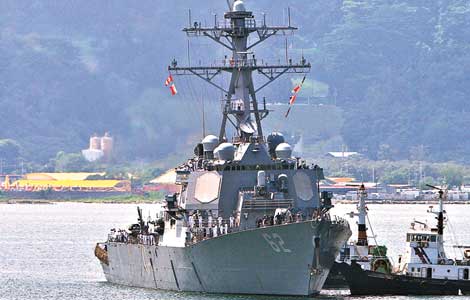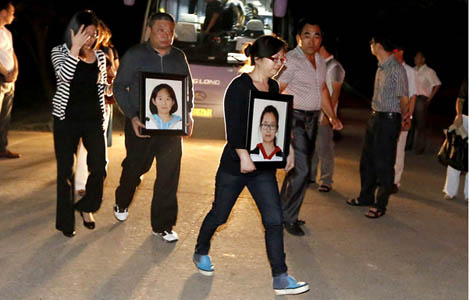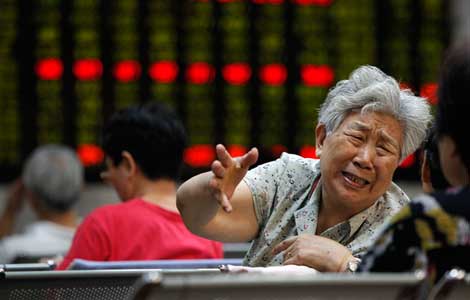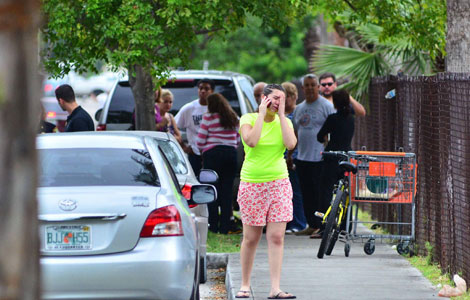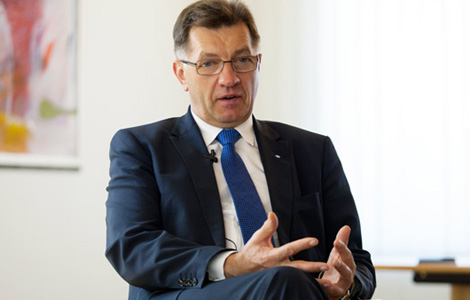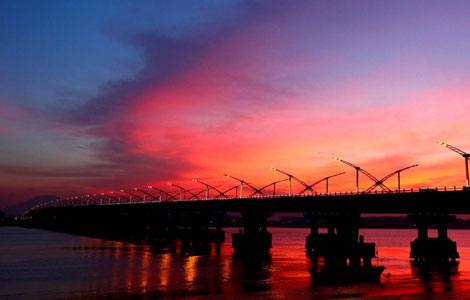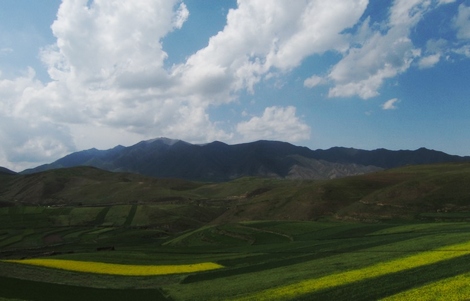Manila's base plan targets China
Updated: 2013-07-30 07:20
By Zhao Shengnan (China Daily)
|
||||||||
|
US destroyer USS Fitzgerald arrives at the former US naval base in Subic Bay, Olongapo City, north of Manila in June. David Bayarong / Agence France-Presse |
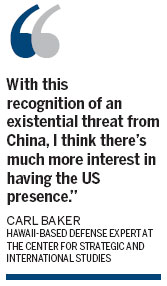
Troop relocation invites outside intervention in region, experts say
Manila's plan to relocate its major air force and navy camps to a former US naval base near the South China Sea is designed to increase pressure on China and introduce more outside forces to the region to contain the country, experts said.
As soon as funding is available, the Philippine government plans to transfer air and naval forces, with their aircraft and warships, to Subic Bay, northwest of Manila, to gain faster access to the South China Sea, Philippine Defense Secretary Voltaire Gazmin said on Sunday.
"It's for the protection of our West Philippine Sea," said Gazmin, using Manila's newly adopted name for part of the South China Sea.
Subic's location will cut the time it takes for fighter aircraft to get to the South China Sea by more than three minutes, compared with flying from Clark Air Base, north of Manila, where some air force planes are currently based, according to a confidential defense department document obtained by The Associated Press.
The natural deep harbor can also accommodate two large warships that the Philippines recently acquired from its ally the United States, and will grant visiting US forces, ships and aircraft temporary access to more of its military camps to allow for more joint military exercises than are currently held, the media reported.
The first US coast guard cutter was relaunched as the Philippines' largest warship in 2011. Philippine President Benigno Aquino III will lead ceremonies on Aug 6 to welcome the second ship at Subic, the Philippine navy has said.
Aggressive stance
Li Guoqiang, deputy director of the Center for Chinese Borderland History and Geography at the Chinese Academy of Social Sciences, said Manila is building up and concentrating its military forces near the South China Sea "with a clear target - China".
The move continues Manila's stance on the issue this year, which violates the spirit of the Conduct of Parties in the South China Sea and increases the risks of conflicts in the region, Li said.
"If all related parties resort to military means as Manila has for a resolution, the region will surely become a powder keg."
China, the Philippines, Malaysia, Vietnam and Brunei have overlapping territorial claims over parts of the South China Sea. China's call for a peaceful solution has recently gained a positive response from nearly all the involved parties, but not Manila.
The report AP cited said that the cost of repairs and improvements at Subic needed for an air force base there will be at least $119 million.
Despite the high cost, the plan is likely to take place with assistance from Washington, which has been shifting its strategic focus to the Asia-Pacific region, and Tokyo, whose ties with Beijing have been strained after Japan illegally "nationalized" China's Diaoyu Islands in the East China Sea, Li said.
Complicating issue
Su Hao, a professor of Asia-Pacific studies at China Foreign Affairs University, said external forces that share the Philippines' goal of containing China are complicating the regional South China Sea issue.
"What Manila sometimes did was to meet the needs of Washington and US allies, to seek more support from them," he said.
Japanese Prime Minister Shinzo Abe presented Manila 10 patrol boats for the country's weak naval forces last week, during his third trip this year to Southeast Asia.
The US-based Military Times website said that with the Pentagon's strategic focus shifting to the Pacific, the Philippine bases are an ideal stopping point that's roughly 1,600 km west of Guam, where four US ships are based.
"With this recognition of an existential threat from China, I think there's much more interest in having the US presence," the media quoted Carl Baker, a Hawaii-based defense expert at the Center for Strategic and International Studies, as saying.
But Su said the role Washington can play in the future is still unclear. "The US would like to see Manila posing threats to China or to back Manila behind the scenes, but it is reluctant to have open conflicts with China," he said.
AP contributed to this story.
zhaoshengnan@chinadaily.com.cn
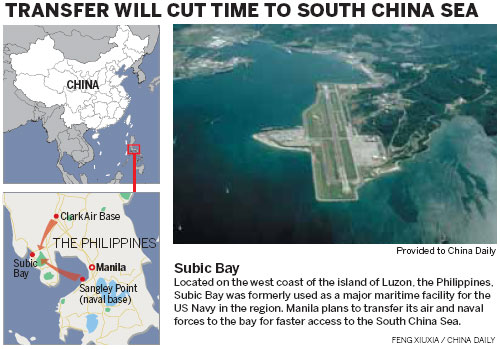
(China Daily USA 07/30/2013 page6)
Most Viewed
Editor's Picks

|

|

|

|

|

|
Today's Top News
Former US president plans to visit DPRK
China struggles to retain talents
Families of crash victims to sue Asiana in the US
Detroit: Gold mine for China
Major SOEs eye profits from abroad
Train collision kills at least 44 in Switzerland
Sino-Japanese summit ruled out
Manila's base plan targets China
US Weekly

|

|


